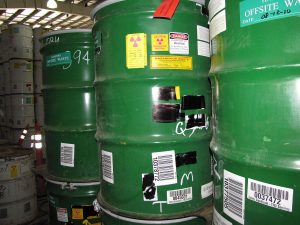
Dozens of Republican and Democratic Lawmakers from the Great Lakes states sent a letter to Canada’s newly appointed Minister of Foreign Affairs (on February 1, 2017) to make clear their opposition to Ontario Power Generation’s proposed nuclear waste repository on the shores of Lake Huron.
Michigan U.S. Democratic Congressman Dan Kildee tells Great Lakes Now, “Burying nuclear waste less than a mile from Lake Huron just doesn’t make sense and is too much of a risk to take, especially considering nuclear material remains radioactive for thousands of years.”
Kildee says the letter of protest has bipartisan support. He says, “I continue to work with Democrats and Republicans to call attention to this threat to our Great Lakes, and I implore that Canada considers a different location for a site that is outside the Great Lakes basin. Surely in the vast land mass that comprises Canada, there must be a better place to permanently store nuclear waste than on the shores of Lake Huron.”
Michigan U.S. Republican Congressman Dave Trott also signed the letter. He tells Great Lakes Now, “Representing one-fifth of the world’s fresh surface water, the Great Lakes are one of the most critical and sensitive ecosystems in the world, and I am alarmed by Ontario Power Generation’s plan to bury nuclear waste within a mile of their shores.” Congressman Trott says, “Today, I voiced my, Oakland County’s, and over 23 million people’s opposition to this dangerous proposal and urged Minister Freeland to require OPG to select a location outside the Great Lakes Basin.”
So far, 186 local, county and state governments in the U.S. and Canada have passed resolutions opposing the proposed nuclear waste repository.
In the letter, the lawmakers ask Minister Chrystia Freeland to require Ontario Power Generation to select a site that is outside the Great Lakes basin, saying “permanently burying nuclear waste so close to the drinking water of nearly 40 million people is just too risky.”
The letter also says Ontario Power Generation has purposely downplayed opposition to the potential waste site. In a report on the proposal the company states , “Research shows that there is little interest among the general public regarding the DGR Project at the Bruce Nuclear site.” The lawmakers say, “We vehemently disagree with this conclusion.”
Ontario Power Generation, a Canadian energy corporation, has proposed building the nuclear waste facility in Kincardine, Ontario about two thousand feet deep into solid rock formations about a mile from the shores of Lake Huron. It would store low and intermediate level radioactive waste.
Great Lakes Now contacted Ontario Power Generation for comment. No response so far. But on the company’s website, it says “one of the safest places to store low and intermediate level nuclear waste is in a deep geologic repository (DGR).” The company describes low and intermediate-level waste as mop heads, gloves, clothes and floor sweepings, as well as used filters and resins, and reactor components.
In 2015, after several hearings with testimony and reports from scientists, a Canadian review panel endorsed the project to build the $2.4 billion nuclear waste facility in the geological formations about a mile from the bottom of Lake Huron.
Spokesperson for the group called “Stop The Great Lakes Nuclear Dump”, Beverly Fernandez, tells Great Lakes Now, “Putting a nuclear waste dump beside the Great Lakes is more than risky; it is a knowing disregard for the health of millions of people.” Hernandez says there are only 3 deep nuclear waste dumps containing radioactive nuclear waste on the entire planet, and all three have failed and leaked. She says, ” Why would you place the Great Lakes – the largest supply of fresh water on our planet – at risk of radioactive contamination, when this risk need not be taken? Some of the radioactive nuclear waste to be put in this dump remains radioactive and lethal for 100,000 years. No scientisit or geologist can provide us with a 100,000 year guarantee that this nuclear waste dump will not leak and contaminate the Great Lakes.”
The Canadian government will continue to receive public comment on the proposal until March 4th. A final decision is expected in September.
Great Lakes Now contacted Ontario Power Generation for comment; the following is the company’s official response:
Ontario Power Generation Spokesperson Kevin Powers tells Great Lakes Now the proposal for the DGR (Deep Geological Repository) has been researched for more than a decade, and scientists agree it’s safe. He says , “The proposal is to move the waste 100 yards from where it currently sits above ground and then bury it 2,230 feet down into some of the most impermeable rock in the world. This rock was created 450 million years ago in an ancient ocean and has survived intact over nine glacial periods and the Continental divide. This proposal would take this waste and enclose it in this rock and seal it, containing it forever. “
Sellers says he knows of only one DGR leak so far. He says, “The only DGR (Deep Geological Repository) accident I’m aware of was in Carlsbad, New Mexico when a container disrupted below ground. It WAS a release of radiation, but the release to the environment was below regulatory limits.“
OPG’s Kevin Powers says, “Scientists from around the world have studied this proposal and agree that this would keep the lake safe. It underwent the most rigorous form of assessment in Canada. More than 20, 000 pages of evidence shows this is the right place and right time for the DGS repository.”
To view the full text of the letter opposing the nuclear waste facility near Lake Huron, go here.





